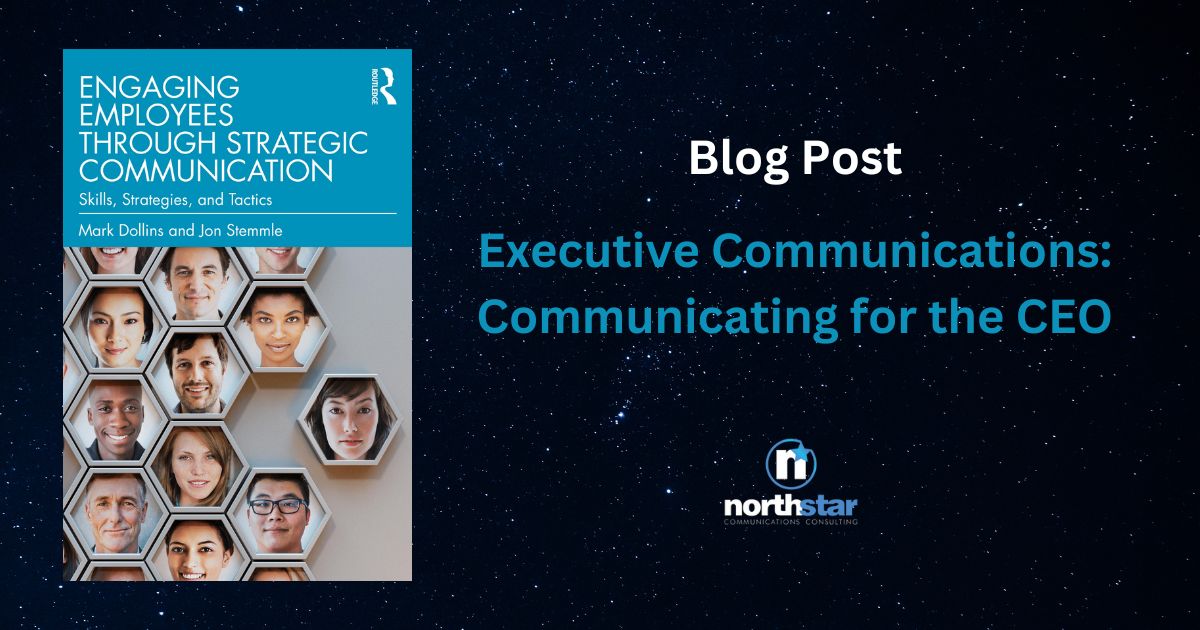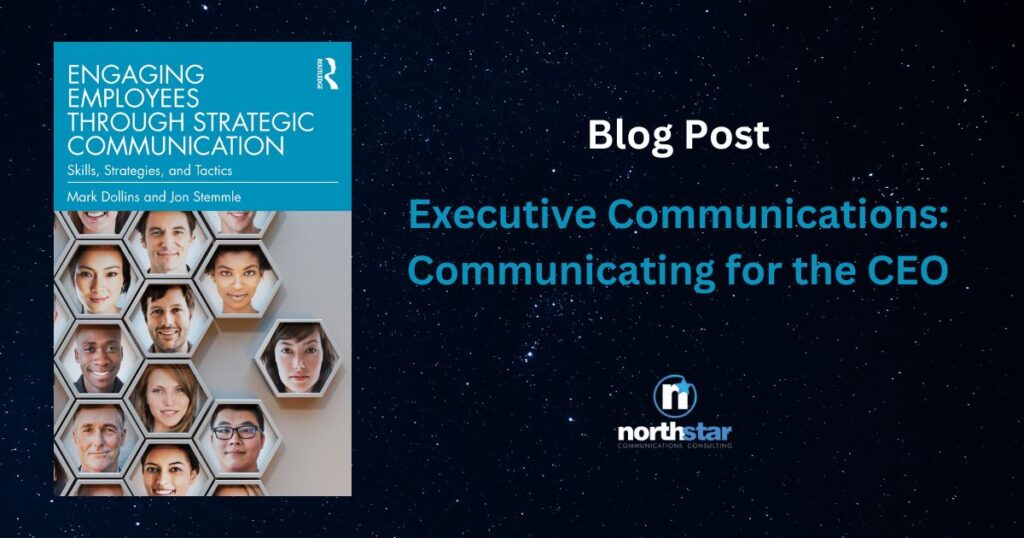
Executive Communications
This blog post briefly summarizes Chapter 9 of the book Engaging Employees Through Strategic Communication by Mark Dollins and Jon Stemmle. Visit engage-employees.com to grab your copy today.
Understanding how to help executives communicate is central to any, and every, successful employee communications effort.
For just about any organization, the practical definition will include supporting the CEO or the most senior leader in every organization with communications to a wide range of stakeholders. Many more definitions will include helping C-suite executives in ways that could include providing communications support for the Chief Financial Officer, Chief Human Resources Officer and Chief Digital Officer, among others.
Still other communications functions may define executive communications to include providing communications counsel, tools and strategy to support all of those roles — plus managers or people leaders — essentially reaching every leader who has one or more direct reports. Clearly, the broader the definition for who is included in executive communications, the greater the resources required to support them and the greater the differences in levels of support provided.
Regardless of who is included in any definition of executive communications, one thing is certain. Whatever an executive in an organization communicates to a set of stakeholders — inside or outside the enterprise — the line between internal and external communications becomes invisible. A CEO communicating to shareholders and financial analysts that his or her company is restructuring, or merging with another company, knows that every employee with a Google Alert will know what’s being communicated at almost the same time. Conversely, a CFO communicating cost cutting measures internally knows that the details of that initiative will reach financial analysts almost concurrently.
That’s the efficiency and speed of digital communications in action, and it highlights why every executive communications function must work in lock step with employee communications and external communications. In fact, in many organizations, executive and employee communications are combined, and managed, by a single communications leader. In others, it may be separated.
The reason executive and employee communications teams are structured either together or apart can reflect competencies of communications professionals in those roles, and the unique requirements that senior executives need. Often, the biggest skill set that can influence whether they are combined in a single organization, or not, is speech writing. It’s a competency that demands very deep and specialized skills that include storytelling, writing, executive counseling and audience analysis, among others.
The skill of a gifted speech writer to identify and capture the authentic “voice” of the CEO or senior leader is highly valued. That same communication professional may not have the skill sets or bandwidth to lead broader employee communication strategies. Similarly, those who lead employee communications may not have the aptitude or bandwidth to deliver C-suite communications needs for both internal and external audiences. An executive with a more significant external speaking agenda, for example, may have need for communications support from a professional who is more engaged with external stakeholders. A chief communications officer may choose to have a dedicated executive communications professional, or professionals, to ensure the CEO or most senior leader is fully supported. It can be a puzzle for the CCO to find the right blend of talent and time on his or her team, and sometimes it can be a combination of the CCO and a speech writer or executive communications leader.
CEO Communications
It sounds simple on the surface, but supporting the CEO communications agenda is demanding, complex, and rewarding for those who do it well.
The unique needs of each chief executive define the level of communication support needed. From the “Bring me my speech writer. I have something to say” tactical needs to the strategic advisor and counselor who sets the CEO’s communication agenda, the range is broad.
A strategic executive communications function not only delivers day-to-day communications for the chief executive; it sets the agenda. That requires an executive communications leader to understand where, when and how the CEO will deliver maximum impact when he or she communicates. CEOs universally have calendars packed with obligations, demanding that communication activities be efficient and highly impactful. Setting the agenda that delivers on those expectations requires partnership with subject matter experts to understand customer needs, the regulatory environment, media relationships (in concert with external communications professionals), non-government organizations (NGOs), investors and a host of different internal stakeholders.
While a broader-scale speaking platform may be the primary driver for any executive to get to Davos, or deliver a TED Talk, the opportunity for media and other influencer communications in — and around –those events is critical for maximizing the investment of time and effort to reach those destinations. Rarely are these kinds of events “one and done.” That’s where we see the role of executive communications taking on great complexity, and the need for attention to detail rise considerably.
For example, a CEO’s executive communications agenda at the World Economic Forum likely would feature an agenda that includes delivering a keynote address, meeting with several media outlets, connecting with heads of state and participating in a panel discussion — all in one morning or day, and at different venues. That event, in particular, has stringent requirements that limit the number of visitors to Forum venues, and all must complete an involved credentialing process. The logistics of getting the CEO from one venue to another, working through security check-in processes and ensuring introductions and meetings take place as planned all combine to paint a picture of what executive communications often demands.
To be clear, that kind of agenda is rarely executed without significant alignment and coordination with external communications professionals, government affairs leaders and a host of other subject matter experts. The ability to partner with other communicators and subject matter experts is paramount.
From writing a short toast to honor or say thanks, to doing “listening tours” with employees, the CEO’s needs for communications support span a wide range of events and populations. The executive communications professional must be responsive enough to turn on a dime, and planful enough to see well beyond the needs of the day — connecting stories, messaging platforms and business strategies with dramatically different audiences.
Looking at internal communication needs, executive communications professionals have an equally — if not ever greater — set of demands on them. Chief executives have significant demands placed upon them and their chief Human Resources Officers to ensure employees are engaged in the organization’s business priorities, and the CEO’s communications agenda is a critical enabler.
Are you interested in learning more about executive communications? Pick up a copy of Engaging Employees Through Strategic Communication to read the full chapter.
Get Your Copy Of The Engaging Employees Through Strategic Communication Book Or Contact North Star Communications Today

The diagram above shows the different topics covered in the book. Take advantage of the opportunity to enhance your organizational communication strategy and engage your employees effectively by getting your hands on the highly recommended book, Engaging Employees Through Strategic Communication by Mark Dollins and Jon Stemmle. Piqued your curiosity? Want to know why change communications, Block Chain, Artificial Intelligence and employee activism will shape our near-term future? Visit engage-employees.com to grab your copy today.
If you’re looking for expert guidance in implementing change communications, talent development, and coaching in your organization, look no further than North Star Communications Consulting. Contact us today to schedule a free consultation and take the first step toward transforming your organizational communication approach.


